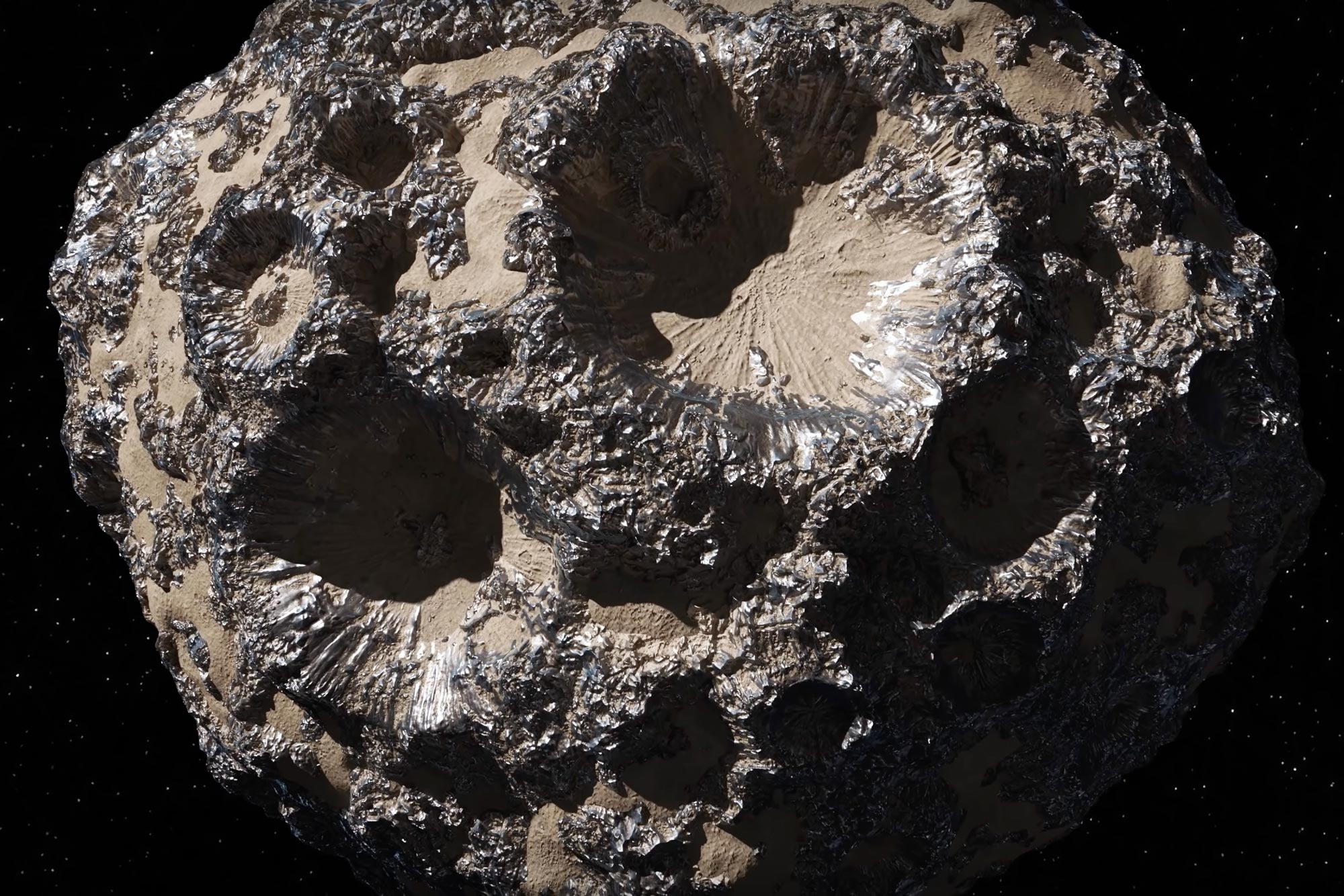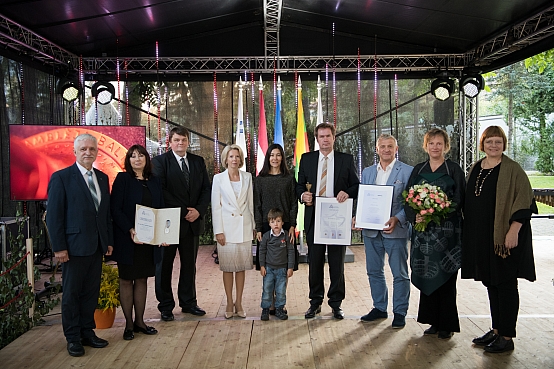Astronomi MIT un citur ir kartējuši asteroīda Psyche sastāvu, atklājot metāla, smilšu un akmeņu virsmu. Pateicība: NASA ekrānuzņēmums
Asteroīda Psyche daudzveidīgā virsma liecina par dinamisku vēsturi, kas var ietvert minerālu izvirdumus, asteroīdu kratīšanas efektus un trūkstošu akmeņainu apvalku.
Vēlāk šogadUn[{” attribute=””>NASA is set to launch a probe the size of a tennis court to the asteroid belt, a region between the orbits of Mars and Jupiter where remnants of the early solar system orbit the sun. Once within the asteroid belt, the spacecraft will zero in on Psyche, a large, metal-rich asteroid that is thought to be the ancient core of an early planet. The probe, named after its asteroid target, will then spend close to two years orbiting and analyzing Psyche’s surface for clues to how early planetary bodies evolved.
Ahead of the mission, which is led by principal investigator Lindy Elkins-Tanton ’87, SM ’87, PhD ’02, planetary scientists at MIT and elsewhere have now provided a sneak peek of what the Psyche spacecraft might see when it reaches its destination.
In a paper published on June 15, 2022, in the Journal of Geophysical Research: Planets, the planetary science team presents the most detailed maps of the asteroid’s surface properties to date, based on observations taken by a large array of ground telescopes in northern Chile. The maps reveal vast metal-rich regions sweeping across the asteroid’s surface, along with a large depression that appears to have a different surface texture between the interior and its rim; this difference could reflect a crater filled with finer sand and rimmed with rockier materials.

This illustration, updated in April 2022, depicts NASA’s Psyche spacecraft. Set to launch in August 2022, the Psyche mission will explore a metal-rich asteroid of the same name that lies in the main asteroid belt between Mars and Jupiter. The spacecraft will arrive in early 2026 and orbit the asteroid – also shown in this illustration – for nearly two years to investigate its composition. Credit: NASA/JPL-Caltech/ASU
Overall, Psyche’s surface was found to be surprisingly varied in its properties.
The new maps hint at the asteroid’s history. Its rocky regions could be vestiges of an ancient mantle — similar in composition to the rocky outermost layer of Earth, Mars, and the asteroid Vesta — or the imprint of past impacts by space rocks. Finally, craters that contain metallic material support the idea proposed by previous studies that the asteroid may have experienced early eruptions of metallic lava as its ancient core cooled.
“Psyche’s surface is very heterogeneous,” says lead author Saverio Cambioni, the Crosby Distinguished Postdoctoral Fellow in MIT’s Department of Earth, Atmospheric and Planetary Sciences (EAPS). “It’s an evolved surface, and these maps confirm that metal-rich asteroids are interesting, enigmatic worlds. It’s another reason to look forward to the Psyche mission going to the asteroid.”
Cambioni’s co-authors are Katherine de Kleer, assistant professor of planetary science and astronomy at Caltech, and Michael Shepard, professor of environmental, geographical, and geological sciences at Bloomsburg University.
Telescope Power
The surface of Psyche has been a focus of numerous previous mapping efforts. Researchers have observed the asteroid using various telescopes to measure light emitted from the asteroid at infrared wavelengths, which carry information about Psyche’s surface composition. However, these studies could not spatially resolve variations in composition over the surface.
Cambioni and his colleagues instead were able to see Psyche in finer detail, at a resolution of about 20 miles per pixel, using the combined power of the 66 radio antennas of the Atacama Large Millimeter/submillimeter Array (ALMA) in northern Chile. Each antenna of ALMA measures light emitted from an object at millimeter wavelengths, within a range that is sensitive to temperature and certain electrical properties of surface materials.
“The signals of the ALMA antennas can be combined into a synthetic signal that’s equivalent to a telescope with a diameter of 16 kilometers (10 miles),” de Kleer says. “The larger the telescope, the higher the resolution.”
On June 19, 2019, ALMA focused its entire array on Psyche as it orbited and rotated within the asteroid belt. De Kleer collected data during this period and converted it into a map of thermal emissions across the asteroid’s surface, which the team reported in a 2021 study. Those same data were used by Shepard to produce the most recent high-resolution 3D shape model of Psyche, also published in 2021.
Kreisajā pusē šī karte parāda Psyche virsmas raksturlielumus, sākot no smilšainiem (violeta/zema) līdz akmeņainiem (dzelteniem/augstiem) apgabaliem. Karte labajā pusē parāda minerālu pārpilnību Psihē, sākot no zemas (violeta) līdz augstai (dzeltenai).
lai panāktu maču
Jaunajā pētījumā Cambioni veica Psyche simulācijas, lai noskaidrotu, kuras virsmas īpašības varētu vislabāk atbilst un izskaidrot izmērītās siltuma emisijas. Katrā no simtiem simulēto scenāriju viņš kartēja asteroīda virsmu ar dažādām materiālu kombinācijām, piemēram, reģionus ar dažādu minerālu daudzumu. Viņš modelēja asteroīda rotāciju un izmērīja, kā uz asteroīda imitētie materiāli izstaro siltumu. Pēc tam Campione meklēja simulētās emisijas, kas vislabāk atbilst faktiskajām emisijām, ko mēra ALMA. Šis scenārijs, pēc viņa domām, atklās visticamāko asteroīda virsmas materiāla karti.
“Mēs veicām šīs simulācijas katrā reģionā, līdz varējām noteikt virsmas īpašību atšķirības,” saka Campione.
Pētījumā tika izveidotas detalizētas Psyche virsmas īpašību kartes, kas parāda, ka asteroīda saskarne, iespējams, ir pārklāta ar daudz dažādu materiālu. Pētnieki uzsvēra, ka Psihes virsma kopumā ir bagāta ar minerālvielām, bet minerālvielu un silikātu pārpilnība mainās atkarībā no tās virsmas. Tas var būt vēl viens mājiens, ka asteroīdam tā veidošanās sākumā varēja būt silikātiem bagāta mantija, kas kopš tā laika ir pazudusi.
Viņi arī atklāja, ka, asteroīdam riņķojot, materiāls lielas padziļinājuma apakšā – iespējams, krāteris – mainīja temperatūru daudz ātrāk nekā materiāls gar malu. Tas norāda, ka krātera dibens ir klāts ar smalkgraudaina materiāla “baseiniem”, piemēram, smiltīm uz zemes, kas ātri uzsilst, savukārt krātera malas veido lēnāks, siltāks akmeņains materiāls.
“Uz maziem asteroīdiem ir novēroti smalkgraudaina materiāla dīķi, un to gravitācija ir pietiekami zema, lai virsmu satricinoši triecieni izraisītu smalkāka materiāla agregāciju,” saka Kampione. “Bet Psihe ir liels ķermenis, tāpēc, ja depresijas apakšā uzkrājas smalks graudains materiāls, tas ir diezgan interesanti un noslēpumaini.”
“Šie dati liecina, ka Psyche virsma ir neviendabīga, ar ievērojamām atšķirībām sastāvā,” saka Simone Marchi, Dienvidrietumu pētniecības institūta zinātnieks un NASA Psyche misijas līdzpētnieks, kurš nebija iesaistīts pašreizējā pētījumā. “Viens no Psyche misijas primārajiem mērķiem ir izpētīt asteroīda virsmas sastāvu, izmantojot gamma starus, neitronu spektrometru un krāsu attēlveidotāju. Tātad iespējamā kompozīcijas gēnu klātbūtne ir kaut kas, ko psiholoģijas komanda vēlas pētīt tālāk.”
Atsauce: Saverio Kampione, Katrīna de Klēra un Maikls Šeperds “Asteroīda (16. psihes neviendabīgā virsma”), 2022. gada 19. maijs, pieejams šeit. Ģeofizisko pētījumu žurnāls: planētas.
DOI: 10.1029/2021JE007091
Šo pētījumu atbalstīja EAPS Krosbija izcilā pēcdoktorantūras stipendija un daļēji Heising-Simons fonds.





